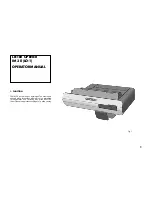
1. Introduction
1.1. Use
(PRECISE 6000) - for the oxygen enrichment of
the air for domestic and clinical oxygen inhalation
therapies.
Only for patients whose lifefunctions are not
directly and permanently dependent on a higher
oxygen concentration in the air.
The oxygen inhalation therapy, however,
should only be carried out after thorough exami-
nation by a physician.
Oxygen for medical purposes is a highly effec-
tive drug. Wrong application might cause side ef-
fects.
The instructions of the physician are to be
strictly adhered to.
Every physical disorder has to be reported to
the physician in attendance immediately.
Contraindications
An oxygen therapy can only be carried out taking
special care in the following cases:
– patients of high age
– obesity
– simultaneous ACTH- or glucocorticoid-treat-
ment
– patients with high carbon dioxid concentration
in arterial (oxygenrich) blood
– poisoning with substances that reduce brea-
thing.
– breathing control disorders in the central ner-
vous system
– fever
The application of a pure oxygen treatment
should not be carried out in case of acute trouble
in breathing (respiratory insufficiency on the base
of a chronic obstructive emphysema bronchitis)
because of the impending decrease in ventilation
of the lungs.
Side effects
Taking into consideration the contraindications,
side effects under normal oxygen pressure are not
to be expected. Patients suffering from insuffi-
cient lung ventilation might encounter a rapid in-
crease of the carbon dioxid value inhaling oxygen.
No clinically significant symptoms have been
diagnosed during treatments with 50% oxygen
for up to seven days. 100% oxygen given for 24
hours, however, leads to cellular and functional le-
sions of the lungs (cell changes of the respiratory
epithelium, secretion inspissation, restriction of
ciliar movement, atelectasis as well as changes of
the minute volume, carbon dioxide dretension
and pulmonial vasodilation)
This means that generally during treatments
carried out over longer periods of time at 1 at-
mosperic excess pressure or at even higher oxygen
pressures in the air, symptoms of poisoning (hy-
poventilation, acidosis up to development of an
edema of the lungs) are to be expected.
It is to be observed that decreasing the partial
pressure too rapidly can lead to a critically insuf-
ficient oxygen supply (hypoxemia).
Newborn children receiving highly concentra-
ted (more than 40%)
oxygen treatments for longer periods of time
can suffer from lesions to the eyelenses that can
cause blindness (retrolenticular fibroplasia).
Apart from that there is danger that bleedings(
pulmonial hemorrhage), cellular and/or functio-
nal disorders of the lungs (focal atelectasis as well
as hyalin membrane lesions with diffuse pulmo-
nary fibrosis) occur.
In order to prevent such a collapse of the lung
functions (bronchopulmonial dysplasia), it is im-
perative to check the oxygen pressure in the arte-
rial (oxygen-rich) blood repeatedly.
1.2. Funcitonal Characteristics
The basic principle of oxygen extraction with the
help of oxygen concentrators is the pressure chan-
ge method following 3 steps:
1st Step: Surrounding air is sucked in by a com-
pressor and is compressed in a container with a
molecular sieve
2nd Step: nitrogen molecules are bound at the
surface of the molecular sieve and are separated
from the oxygen molecules in this way.
The oxygen molecules pass the molecular sieve.
13
Summary of Contents for 006.100
Page 11: ...Operation Manual PRECISE 6000 Oxygen Concentrator ...
Page 20: ...20 ...
Page 21: ...Description de l appareil PRECISE 6000 Concentrateur d oxygène ...
Page 32: ...32 ...














































